Embedded Motion Control 2017 Group 2: Difference between revisions
| Line 266: | Line 266: | ||
3 : there is an exit trough here. | 3 : there is an exit trough here. | ||
These were chosen in this way such that the mazesolver just can pick the direction with the highest value. After | These were chosen in this way such that the mazesolver just can pick the direction with the highest value. After choosing a direction this direction is set to -1 in the node, this ensures that the robot will not take the same direction the next time it comes at this node. | ||
If the robot finds a node with no options to explore it will return to the previous node and explore the next option of this node. | If the robot finds a node with no options to explore it will return to the previous node and explore the next option of this node. | ||
If the robot encounters a node that is already in its list but is not a parent to the previous node it will turn around and it will mark the path in that node as explored(-1). this will prevent the robot form exploring the same path twice from different directions. | If the robot encounters a node that is already in its list but is not a parent to the previous node it will turn around and it will mark the path in that node as explored(-1). this will prevent the robot form exploring the same path twice from different directions. | ||
To ensure the mazesolver only makes decisions when needed a separate function to call the mazesolver was created. This function checks if a new primitive really is a new primitive or that it rather is the previous primitive just shifted a bit, further it checks if we are close enough to the primitive to make a decision. Finally if there is a possible door detected this function will first call a function to check for a door and then call the mazesolver with the outcome of this function. | |||
The door opening function simply checks the average laser distance in 3 zones left right and in front. After checking the distance it will ring the bell wait a few seconds and check again. If one of the distances has increased by a certain threshold a door has opened and the mazesolver will decide to go trough this door. | |||
=== Set-point generation === | === Set-point generation === | ||
Revision as of 18:41, 18 June 2017
TODO
- Iedereen: eigen deel
- Matthijs: evaluatie corridor challenge
- Joeri: evaluatie maze challenge
- Joep: maze challenge architectuur / intro
- Joeri/Iedereen: recommendation (Joeri hoofdverantwoordelijk)
Group Members
| Name: | Report name: | Student id: |
| Matthijs van der Burgh | M.F.B. van der Burgh | 0771381 |
| Joep Linssen | J.M.H.G.H. Linssen | 0815502 |
| Sil Schouten | S. Schouten | 0821521 |
| Daniël Pijnenborg | D.H.G. Pijnenborg | 0821583 |
| Rens Slenders | R. Slenders | 1028611 |
| Joeri Roelofs | J. Roelofs | 1029491 |
| Yanick Douven | Y.G.M. Douven | Tutor |
Minutes
Minutes of team meetings are available here: [1]
Initial design
The initial design can also be found in File:Initial-design-document.pdf
Introduction: The goal of this project is to autonomously solve a maze with a robot (PICO) as fast as possible. The robot has sensors, actuators and a computer on board to navigate through the maze. The computer runs on Linux 14.04 and the program language used for the software is C++. In this section the initial design is discussed, which consist of the requirements, functions, components, specifications and interfaces. This design will be used to build structured software and define required interfaces.
Requirements: To solve the maze problem the following are required
- Finding the exit
- Finding and opening the door
- Avoiding obstacles at all times
- The maze should be solved within 5 min
- All tasks must be executed autonomously
- The system should work on any maze
- The robot mustn't get trapped in loops
Functions: The functions which have to be implemented are subdivided into the different contexts. Motion functions describe how the software gets input from and supplies output to PICO. Skill functions describe how different skills are executed in the software. Lastly Task functions implement task scheduling.
The motion functions have been determined as:
- Basic actuation Give PICO the ability to move around and rotate
- Getting information Receive information from LRF and odometry sensors.
- Opening door Make a sound to open door.
The more advanced skill functions are:
- Mapping Use information from ”Get information” to determine and save a map of the environment. This creates the world model for PICO.
- Localisation Determine where PICO is located in the map created in ”Mapping”. This will most likely be implemented in the same function.
- Object avoidance Use current LRF data to make sure PICO does never hit a wall.
- Maze solving Use the map in combination with current and previous locations within the map to determine a route out of the maze.
- Door and exit detection Using the map to detect if possible doors have been found and if PICO has finished the maze.
The task control implements switching between the following tasks:
- Map making Done throughout the challenge to improve current map.
- Finding doors Done in first stage of the challenge when no door has been found yet
- Finding the exit Once a door has been found and opened the task is to go through the door and finish the challenge.
Software architechture pre-corridor
The initial design can be put into a diagram, which is shown in Fig: figfigfigfigfigfigfigfigfigfigfigfigfigfigfigfigfigfig. Below the diagram a short recap of the skill, world model and task contexts are given, in order of execution.

SLAM
The slam algorithm uses the raw odometry and laser data and processes this into a robot pose and world features. The robot pose is defined as the current position and rotation of Pico with respect to the initial pose of Pic. Features are defined as re-observable landmarks, for example corners of walls, and are saved as locations with respect to the initial pose of Pico. A possible method of SLAM is EKF SLAM, but many different types of SLAM exist.
After evaluating multiple SLAM algorithms, it has been decided that EKF SLAM fits bests with the problem. The reason for this choice is that it works well in circumstances where there are clear landmarks, in our case corners, these landmarks can be used in primitive detection as well. It is also effective for problems of moderate size, the data size will not become huge and slow to process for a few hundred landmarks.
World model
The world model is a data structure that holds the detected features, primitives and pose of the robot. It takes feature and pose data from the SLAM algorithm this information is used by primitive detection to find primitives within the world model. Primitives are locations where a major change of movement direction is possible, a point where a decision has to be made.
The data in the world model is used by the state machine and maze solver to solve the maze challenge. Note that the world model does not do any data processing itself, it is merely a container of data.
State machine
Solving the maze is done in three states:
- Find door
- In this state the maze solver will have to detect if a possible door is near Pico, if so the state is changed to Open door.
- Open door
- When a possible door has been found the bell is to be rang, after which it has to be checked if the door opened. There are two possible outcomes, either there was a door, which opened, or there was no door. In the first case state changes to Find exit, else the state reverts back to Find door
- Find exit
- In the find exit state Pico does not search for doors anymore and has to detect if the exit is crossed in which case Pico has to stop.
Maze solver
The maze solver implements a maze solving algorithm that is able to cope with loops in a maze, for example Trémaux. It takes primitive and pose data from the world model. If Pico is within range of a primitive, a decision is made in which direction to move next and sends this data to the driving skill.
Driving
In the driving skill a driving strategy is to be implemented which is able to avoid obstacles while driving in a set direction, taken from the maze solver. Avoiding obstacles means that laser data is required to measure distances to objects in the world.
For the driving skill the best method was chosen to be a potential field method would be the best choice. Correct implementation makes sure Pico will never hit a wall while driving towards a desired location. A downside of this method is that Pico might get stuck if there a wrong decision is made.
Corridor challenge
Software architecture post-corridor
After the corridor challenge it was decided to take a slightly different approach on the SLAM algorithm and split it into SLAM for localisation and feature detection. This is change has been made since SLAM is already implemented and tested within ROS and known to be robust, and therefore focus can be placed on other crucial tasks as primitive detection.
Maze challenge
General toolset
A distinction is made between skills, which are divided in classes, and toolset functions, which implement supporting functionality. Some of these functions help cope with the non-ideality of the real-world, for example in the ideal situation Pico is placed aligned with the maze correctly every time, laser data is noise free and odometry data starts at 0 everytime. Violations of these situations have to be handled, and preferably only at one point in the code; this provides clarity and, most importantly, negates the situation where two modules would operate on different sets of data, while they should not.
Initialisation
The Maze Solver relies on the directions from the Primitive Detection being correct in the world frame: NORTH, EAST, SOUTH and WEST with respect to the initial rotation of the robot have to actually represent this. Furthermore, since the architecture requires that a new Decision Point can be found by driving in one of these cardinal directions. This adds the requirement of the robot being initialised perpendicular to a wall. Since all corners are approximately right angled this results in available directions at every Decision Point corresponding to the actual NORTH, EAST, SOUTH and WEST.
Solving this problem is fairly straight forward using Feature Detection. From the first two features, which are always in the same section, the angle between the two points is calculated. This angle is then used to turn Pico such that is in alignment with it. This is repeated until the angle is within a threshold of approximately 3 degrees. This process is shown in simulation in Fig. figfigfigfigfigfigfigfigfigfigfigfigfigfigfigfigfigfigfigfig
After aligning with a wall the first decision is made according to a laser measurement which measures for open directions in the starting position. Finally the starting pose of the mapping is set to the aligned pose, which will be used to retrieve pose data at different locations.
Shadow point filtering
Using the Laser Range Finder in practise raises a problem when scanning an ending wall: shadow points appear. They are ghost measurements, placed at an arbitrary distance behind the wall, but always at exactly the angle to the ending, and are caused by the way the sensor works (detecting reflected laser points). An example of such shadow points is depicted in Fig. figfigfigfigfigfigfigfigfigfigfigfigfigfigfigfigfigfigfigfig. Since they negatively effect the Feature Detection and Potential Field, they need to be filtered out.
The Shadow Point Filter uses one attribute of these points to discern and detect them: they commonly don't have many other measured points around them. It thus looks before and after the point in the laser data array for N steps, and checks whether less than M of these points are within a radius r of it. Is this the case, then the point is either removed or set to distance 100. Thus, we keep track of two different arrays, which each have their own usefulness for different applications.
The filter with parameters {N, M, r} = {10, 5, 0.1} applied on the previously depicted figure, is shown in Fig. figfigfigfigfigfigfigfigfigfigfigfigfigfigfigfigfigfigfigfig
Main skill set
The main skill set implements, as the name suggests, skill functions defined in the architecture.
SLAM
Gmapping is a SLAM algorithm present in ROS and is therefore used.
Feature detection
For determining the locations of decision points corner and segment features are required, from which primitive detection can generate decision points. Corner features are defined as locations where two, connected walls meet i.e. a corner, segment features are the features which are not corners which describe beginning and end points of wall segments. In Fig. figfigfigfigfigfigfigfigfigfigfigfigfigfigfig these features are shown, corner features in red and segment features in blue. Since the laser data contains values showing out-of-range data these values are set equal to 100 indicating an open section. In these out-of-range sections no features are set.
The strategy to find segment features is based on the difference between two consecutive laser points, if the difference is greater than a threshold value (set at ................) a segment is detected and both points are set as segment features. For the corner features a split and merge algorithm is applied to every segment (from an even segment feature to the next segment feature, i.e. from 0 to 1 and 2 to 3).
The split and merge algorithm works in the following sequence:
- starting node = segment beginning, ending node = segment end
- dx and dy are calculated between starting and ending node
- distance between measured data and straight line is calculated as:
dist = abs( dy*x - dx*y + x(start)*y(start) - y(end)*x(start) )/ sqrt( dy^2 + dx^2 )
- check if all points are within threshold
if(maximum distance > threshold)
- ending node = index of maximum value
- index of maximum value is a corner node
- goto 2
- done
The split and merge algorithm is also shown in Fig. figfigfigfigfigfigfigfigfigfigfigfigfigfigfig, with some resulting examples in Fig. figfigfigfigfigfigfigfigfigfigfigfigfigfigfig. This split and merge algorithm is tested in Matlab first of which executable code is provided in File:Split-and-merge-matlab.zip.
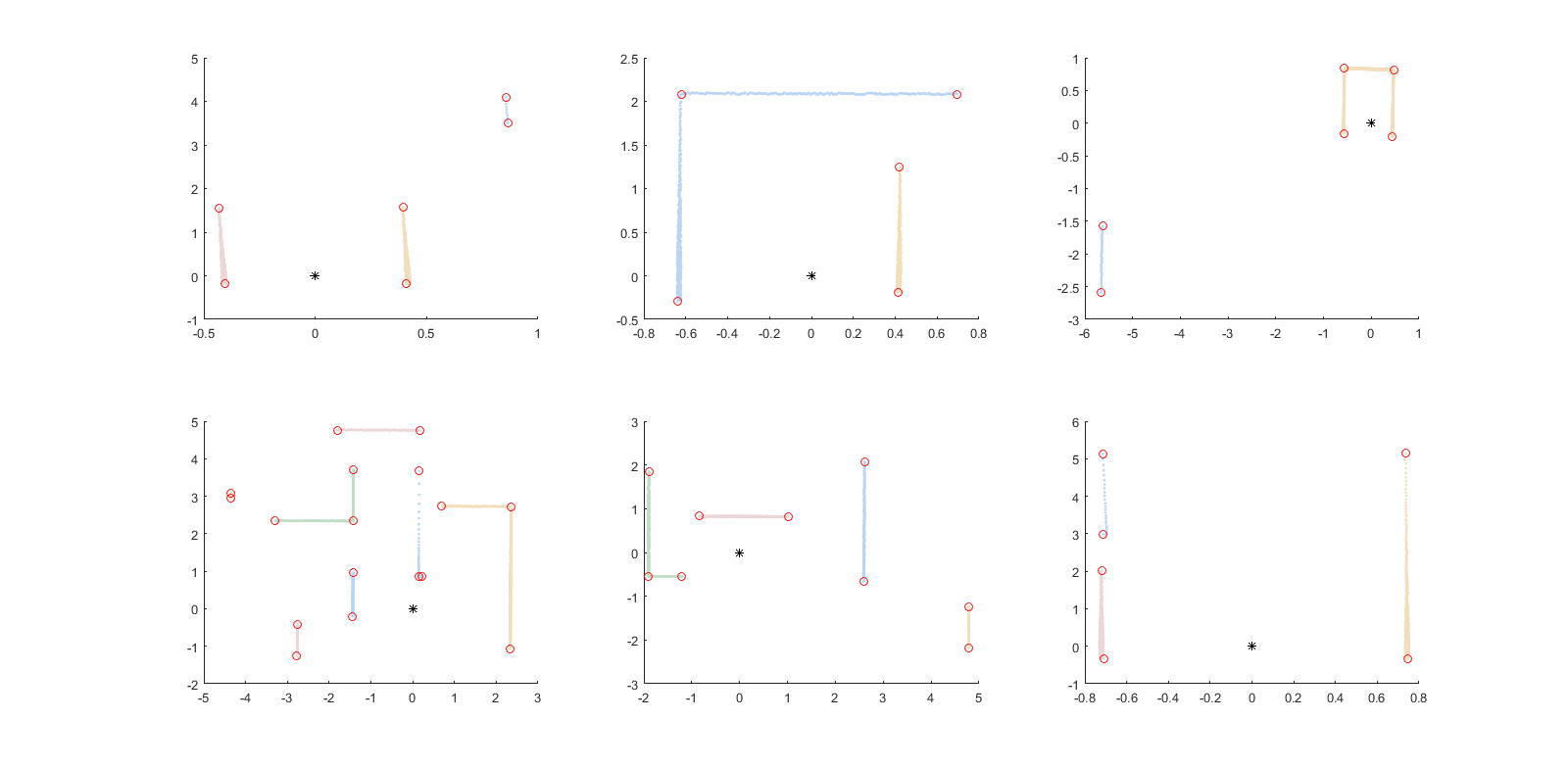
Dependencies: Feature detection uses laser data as its input, therefore the quality of the output depends on the accuracy of the data. If accurate data is supplied the parameters defining the strictness of the detection (i.e. the maximum allowed distance between calculated and measured lines) can be increased. This however comes with a major drawback that shadow points result in walls being split into multiple sections, as the laser data makes a jump for shadow points. To prevent this a basic shadow-point filter is implemented.
Another possible cause of error is how out of range data is handled, if this data is discarded there is are circumstances where two sections are joint together. This happens when the range before an out of range section is equal to the range after an out of range section. A result is that two sections are joint and therefore primitive detection will give a wrong output. An example of this behaviour is shown in Fig. figfigfigfigfigfigfigfigfigfigfigfigfigfigfig where the difference is shown in the corridor challenge case.
Trade offs: As mentioned in the Dependencies, the shadow point filter plays a large role in the quality of the features. In this a trade-off has to be made between filtering bad data and removing relevant information. A strict shadow point filter takes out shadow points but also leads to far-away, correct laser data being removed as well (as one laser increment leads to large range difference.
Primitive detection
The maze can be split up into primitives. A primitive is a certain part of the maze where the robot can make decision. There are 5 decision options: go straight, go back, take a right turn, take a left turn and open door. To determine what kind of primitive a certain part of the maze is, features and sections are used.
The action go straight is possible if no section in front of pico exists or if the section in front of pico is more then 1.2 meters away. A section is in front of pico when a feature is in the first and second quadrant (see figure below). The straight section if also checked if it can be a possible door and is done by looking if the horizontal wall is less then 1.6 meter and if it contains two vertical walls next to the horizontal wall.
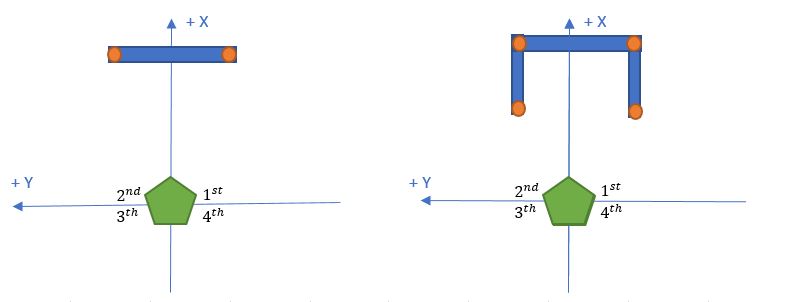
The action take a right turn is possible if enough space is in between two sections or a right section is 1.2 meters away. To determine the space in between two sections, a low and high section need to found. The low section has to start in the fourth quadrant and must contain a feature closest to the robot. The high section has to start in the fourth or first quadrant, must be a higher section as the low section and must contain a feature closest to the robot.
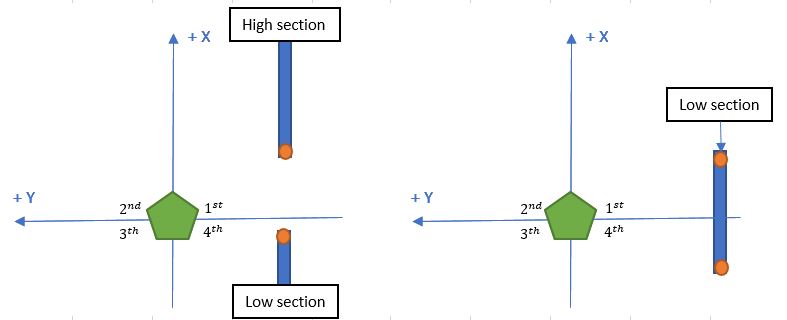
The action take a left turn uses the same method as take a right turn only now the features in the second and third quarter are used.
Now the actions at a certain can be determined locally but the maze solver needs to know them globally. the local actions are converted using the current angle of the robot into global actions (allow north, allow east, allow south and allow west).
The location of a primitive has a global x and y coordinate in the map. The global x location from the robot to the DP must be exactly in the middle of a right/left turn and 0.5 meter in front of dead end or door. The global y location from the robot to the DP is zero. To get the global x and y in the map the x and y location of the robot needs to be added.
Maze solver
The mazesolver is designed to make decisions at each primitive, it has to make decisions in such a way that it will find its way out the maze in preferably the shortest path. It also has to make sure that the robot does not get stuck in a loop.
There are multiple possible algorithms for designing a mazesolver. Since it is not know where the exit of the maze is strategies using a heuristic, like A* will not be considerd. A few options that we did consider are:
Wall follower
This algorithm is very simple it always follows the wall on one side
The disadvantage of this algorithm is that there is a possibility for endless loops
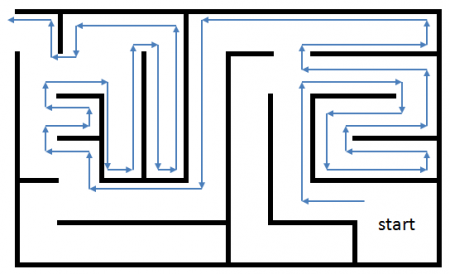
Pledge algorithm This is an extension of the wall follower algorithm, This algorithm also keeps a count of the sum of the turns to avoid obstacles.
Trémaux's algorithm/ Depth-first search The Trémaux's algorithm is an algortihm that remembers the decisions made on a crossing, it uses this information to prevent it form entering the same path twice, therefor it should avoid loops.
The algorithm has the following steps:
- Mark each path once, when you follow it. The marks need to be visible at both ends of the path. Therefore, if they are being made as physical marks, rather than stored as part of a computer algorithm, the same mark should be made at both ends of the path.
- Never enter a path which has two marks on it.
- If you arrive at a junction that has no marks (except possibly for the one on the path by which you entered), choose an arbitrary unmarked path, follow it, and mark it.
- Otherwise:
- If the path you came in on has only one mark, turn around and return along that path, marking it again. In particular this case should occur whenever you reach a dead end.
- If not, choose arbitrarily one of the remaining paths with the fewest number of marks (zero if possible, else one), follow that path, and mark it.
Depth-first is a special class of the tremaux algorithm, where the solver has a preferred order of choosing paths. Its name comes from the fact that this algorithm will always explore an entire branch of a tree before going to the next one.

Breadth-first search With breadth first we will first check how many nodes there are connected to the current node and explore these in a fixed order by number, during each exploration the new connected nodes will be numbered incrementally. The biggest difference with Depth-first search is that at each node first all the options are explored before going one node deeper. https://www.youtube.com/watch?v=ec0IJsiIuWk
The wall follower algorithm is not suitable for our application since we might have loops in our maze. The Pledge algorithm however might work, but is still a relative dumb search method.
The Trémaux's algorithm/depth-first is already a bit smarted since it keeps track of the intersections it has been on. This requires some memory but not an entire map of the maze, since it is simply possible to follow back the wall to the last intersection. Only the coordinates of each intersection with the explored options have to be remembered. This algorithm is better suited for our application than the breadth first algorithm since the breadth first would require the robot to drive back after each iteration while the depth-first only has to drive back on a dead end.
Therefore we decided to use the depth-first algorithm for our mazesolver
Implementation
To implement the Depth-first algorithm we created a class to store the nodes at which decisions where made. Such a node would contain its position in the world frame, and the options for each of the for directions. The for directions are North, East, South and West. These are always absolute directions in the world frame.
The options for each direction are:
-1 : there is a wall in this direction 0 : the first time I entered this node, I came from this direction. 1 : there is a free path in this direction 2 : there was a door in this direction 3 : there is an exit trough here.
These were chosen in this way such that the mazesolver just can pick the direction with the highest value. After choosing a direction this direction is set to -1 in the node, this ensures that the robot will not take the same direction the next time it comes at this node. If the robot finds a node with no options to explore it will return to the previous node and explore the next option of this node. If the robot encounters a node that is already in its list but is not a parent to the previous node it will turn around and it will mark the path in that node as explored(-1). this will prevent the robot form exploring the same path twice from different directions.
To ensure the mazesolver only makes decisions when needed a separate function to call the mazesolver was created. This function checks if a new primitive really is a new primitive or that it rather is the previous primitive just shifted a bit, further it checks if we are close enough to the primitive to make a decision. Finally if there is a possible door detected this function will first call a function to check for a door and then call the mazesolver with the outcome of this function.
The door opening function simply checks the average laser distance in 3 zones left right and in front. After checking the distance it will ring the bell wait a few seconds and check again. If one of the distances has increased by a certain threshold a door has opened and the mazesolver will decide to go trough this door.
Set-point generation
Potential field
To make sure pico never collides with walls a potential-field algorithm is designed. This is implemented in a class and uses the filtered laserdata to calculate the repelling forces. Attraction force is used to move the robot in the desired direction. The ouput of function is a speed in x,y,theta.
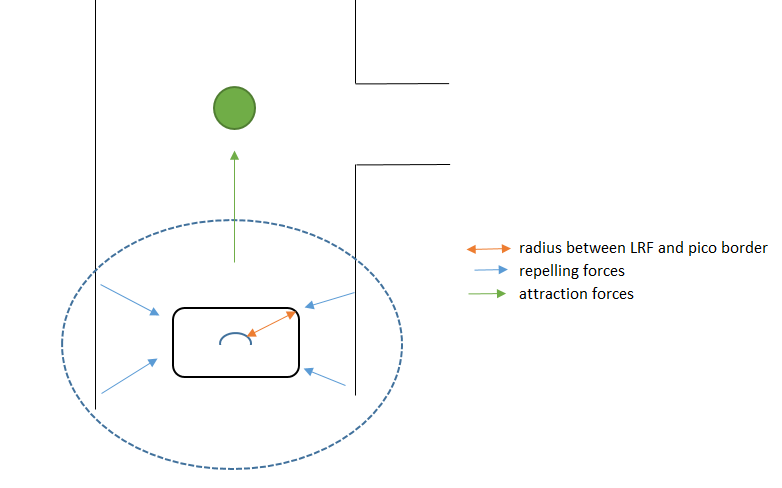
Repelling forces
First the laserdata: range and angle is converted to x/y data. The repelling forces are calculated by: Frep = Sum[abs(r_laser-radius)^-3*-Fbad]
The radius between the LRF and the edges of pico is substracted from the laser radius, in this way there is an infinite repelling force when pico is
touching the walls. Fbad is a factor which is determined during tests.
Attraction force
Speed calculation
Files
Initial design document: File:Initial-design-document.pdf
Initial design presentation: File:Initial-design-presentation.pdf